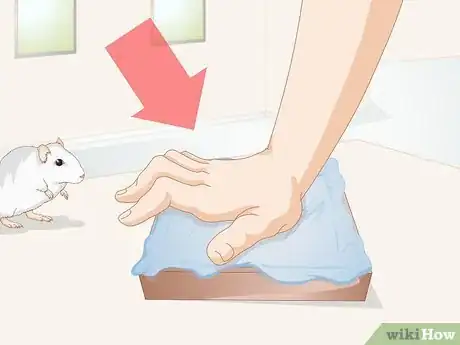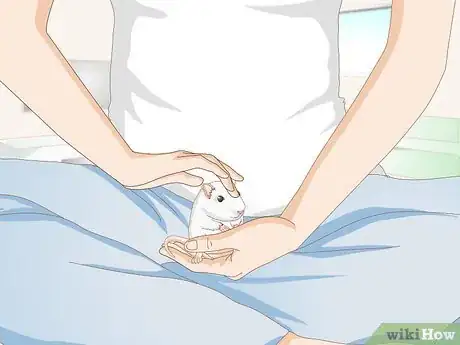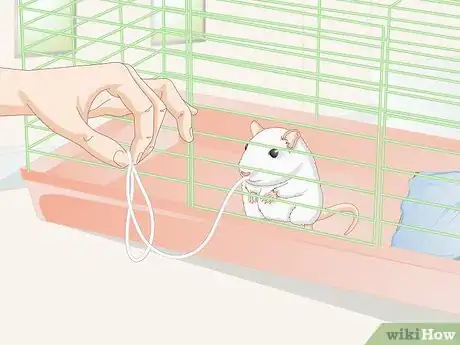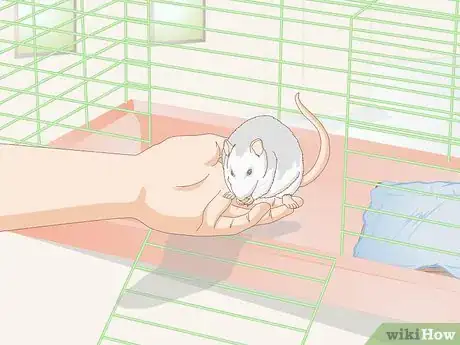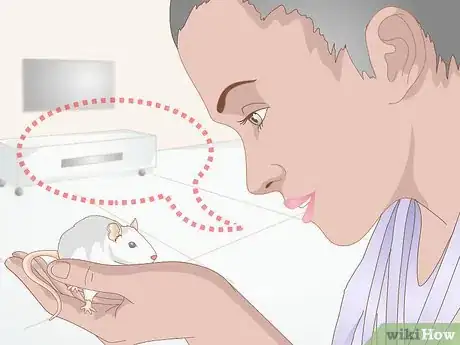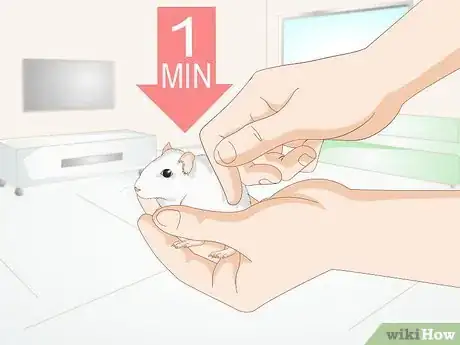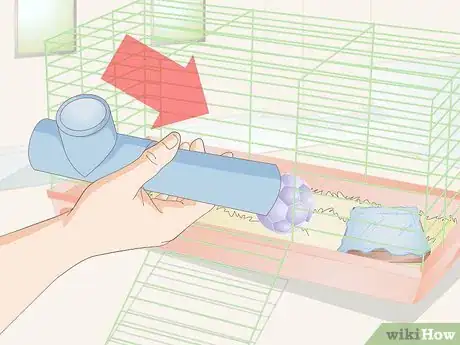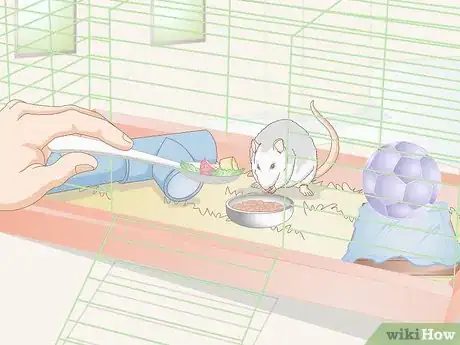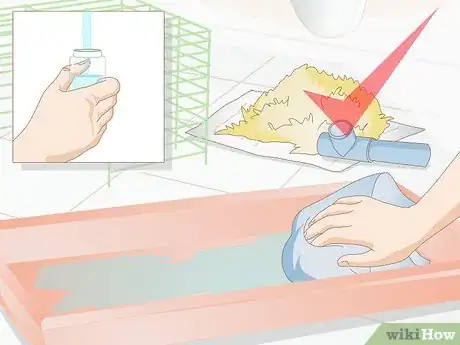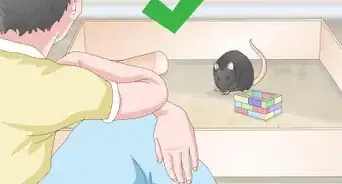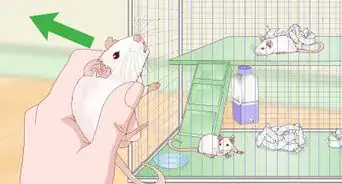This article was co-authored by Brian Starr. Brian Starr is a Rat Specialist and Breeder and the Owner of OC Dumbos out of Central Florida. As America’s only breeder of pet Roof Rats, Brian and OC Dumbos specialize in rat breeding, training, and care. Years of experience and several generations of careful breeding have allowed Brian and OC Dumbos to create a line of tame Roof Rats, bred to make friendly, fun pets. In addition to offering rat accessories and training resources, OC Dumbos also offers free Roof Rat adoptions.
There are 8 references cited in this article, which can be found at the bottom of the page.
This article has been viewed 25,880 times.
Rats are often associated with negative feelings, but many people have found that these social and intelligent animals make great pets. Socializing a pet rat is one of the best ways to enjoy her, and you may find that she eventually enjoys being held and snuggling with you. By starting the socialization process as soon as possible and keeping your pet rat in a comfortable environment, you can socialize your rat and enjoy her company!
Steps
Training Your Rat
-
1Minimize her stress. Rats can be stressed by new environments.[1] Minimizing her stress the first few days you have her can make it easier to socialize her.[2] The following can help your rat get used to her environment:
- Preparing her nesting box before she arrives
- Using the type of food and bedding she’s used to before slowly introducing new products
- Allowing her to settle by not handling her.[3]
-
2Start socializing as soon as possible. In order to socialize your rat most effectively, start training her as soon as she appears comfortable. Babies to older rats respond well to socialization with the proper guidance from early on in your relationship.
- Avoid being discouraged if your rat is older. You can socialize her as soon as she joins your family and is comfortable in her new environment. Just be aware that it might take a little more time, effort, and patience on your part.[4]
- Remember that rats are intelligent and social. Proper handling and behavior from you can help ease the process.
Advertisement -
3Give your rat a treat. Once of the best ways to start to get your rat used to you is to give her treats.[5] This can help foster her trust that you are her friend and will care for her.[6]
- Give her treats like a piece of cooked pasta or a bit of pizza crust.
- Open her cage and gently place your hand inside with the treat in your palm.
- Allow your rat to sniff your hand and take the treat. If there are multiple people in your household, make sure everyone gives your rat occasional treats so she learns to trust them.
- Continue giving your rat treats until she takes the treat without sniffing you. This is a good sign she’s ready for handling.
- Avoid feeding her treats through the cage bars, which may teach her to snap at your fingers.[7]
-
4Pick up your rat. If your rat appears comfortable with you from giving her treats, try picking her up. Be aware that rats are very active and may not want to be held or only want held when they’re sleepy.[8]
- Allow your rat to come out of her cage on her own accord. Don’t invade her space by putting your hand in the cage.[9]
- Place one hand under the bottom of your rat and the other under over her back to provide her adequate support.
- Use a small towel to pick her up if she nibbles or bites because rats are less likely to bite a towel.[10] Avoid using gloves.[11]
-
5Reassure your rat during handling. Rats can scare easily, especially in the early phases of socialization.[12] Give your rat reassurance through talking and other behaviors while you’re holding her.[13]
- Talk to your rat in a soft voice throughout the handling session. Consider positive reinforcement that you repeat consistently. For example, “what a beautiful girl you are Sophie, aren’t you nice.”[14]
- Pet her gently while holding and talking to her.[15]
- Keep the area as quiet as possible. Avoid loud noises such as yelling and keep other pets like cats or dogs in another room.[16]
- Allow your rat to burrow to help her feel secure during the sessions.[17]
- Give her another treat before you put her back in the cage. This helps her trust you and associates handling with treats.[18]
-
6
-
7Play with your rat. When your rat is hand-tamed and comfortable with you and her surroundings, it’s time to let her play outside the cage. This can keep her stimulated and physically fit.
- Remember that rats need a lot of stimulation because they’re social. If your rat doesn’t have a companion, she’ll need about 4 hours of human interaction a day.
- Set up a secure play area outside of your rat’s cage. You can place some toys in the area and should make sure you’re present to enjoy her and keep her from chewing on anything.
- Be aware that out-of-cage play time is vital to the health of your rat.
- Go back to handling if your rat seems scared by the playtime outside of her cage. Continue to handle her for a bit and then try reintroducing her to playtime.[21]
- Give her a treat when playtime is done.[22]
Giving Your Rat a Comfortable Home
-
1Set up a comfortable cage. Part of socializing your rat is making sure she has a comfortable and clean home. Put together a cozy cage for your rat to promote her health and socialization.
- Get a solid-bottom, powder-coated wire cage in the largest size you can afford.[23] A ferret cage or aquarium with screen top will also work.
- Put the cage away from strong heat sources like radiators or the sun or in any breezy or unheated areas.[24] Place it in an area that isn’t brightly lit, which can damage her eyesight.[25]
- Line the cage with bedding from aspen or pelleted recycled paper. Be aware that pine and cedar chips contain oils that can harm your rat.
- Put a small box or flower pot in the cage for your rat to sleep or rest.
- Add toys such as PVC piping, swings, ropes, and a chew toy.
-
2Feed your rat. Rats have a lot of energy and a high metabolism, so feeding them properly is important to their health. However, rats are also prone to obesity, so it’s equally important to make sure you’re giving them the right amount and types of food.[26]
- Give your rat a small bowl of lab blocks every day.[27]
- Give her about one tablespoon of fruit and vegetable treats every day. For example, you can give her some greens and a broccoli floret, or a slice of apple or whole strawberry.[28]
- Give her a hard treat like a dog biscuit or branch from a fruit tree once a week to keep her teeth healthy.[29]
- Feed your rat at night because rats are nocturnal.[30]
- Place an attachable water bottle in the cage so she can drink continuously.
-
3Consider adding a companion. Rats are very social and it’s recommended to keep them in pairs at a minimum. Consider giving your rat a companion to keep her happy, stimulated, and healthy.
- Get a pair of females if you’ve never had rats before. This can minimize the risk of rats breeding.
- Make sure the rats are neutered or spayed if you want a male and female rat.
- Be aware that two male rats may fight if introduced later in life.
- Introduce your rats in a neutral territory that is not their respective cages.[31]
- Rats associate by smell. Consider adding a little vanilla essence, which is non-toxic, to eat animal’s back so that they get used to each other.[32]
- Place a new nest box and place to hide for each rat.[33]
-
4Maintain the cage’s cleanliness. It’s important to your rat’s well being to keep her cage clean.[34] Clean the cage every day and do a complete cleaning once a week.
- Take out any soiled material, dropping, and uneaten food every day.
- Clean and refill the water bottle every day.
- Replace dirty bedding and scrub down the cage with soapy water once a week.
Expert Q&A
-
QuestionHow do I get my rat to trust me?
 Brian StarrBrian Starr is a Rat Specialist and Breeder and the Owner of OC Dumbos out of Central Florida. As America’s only breeder of pet Roof Rats, Brian and OC Dumbos specialize in rat breeding, training, and care. Years of experience and several generations of careful breeding have allowed Brian and OC Dumbos to create a line of tame Roof Rats, bred to make friendly, fun pets. In addition to offering rat accessories and training resources, OC Dumbos also offers free Roof Rat adoptions.
Brian StarrBrian Starr is a Rat Specialist and Breeder and the Owner of OC Dumbos out of Central Florida. As America’s only breeder of pet Roof Rats, Brian and OC Dumbos specialize in rat breeding, training, and care. Years of experience and several generations of careful breeding have allowed Brian and OC Dumbos to create a line of tame Roof Rats, bred to make friendly, fun pets. In addition to offering rat accessories and training resources, OC Dumbos also offers free Roof Rat adoptions.
Rat Specialist & Breeder Keep in mind that most young rats are very timid. They're prey animals. You're big and scary to them. So you need to work on making your rat comfortable being around you. You can do that by teaching the rat to associate being around you with good things, like food, being petted, and being played with. One of the best things you can do is give your rat treats while they're hanging out with you. They'll become your buddy. It always works.
Keep in mind that most young rats are very timid. They're prey animals. You're big and scary to them. So you need to work on making your rat comfortable being around you. You can do that by teaching the rat to associate being around you with good things, like food, being petted, and being played with. One of the best things you can do is give your rat treats while they're hanging out with you. They'll become your buddy. It always works.
Warnings
- Avoid grabbing at your rat. Rats are not prone to biting, but you may scare them.⧼thumbs_response⧽
References
- ↑ http://www.humanesociety.org/animals/rats/tips/welcoming_new_rat.html?credit=web_id139896192
- ↑ http://www.humanesociety.org/animals/rats/tips/welcoming_new_rat.html?credit=web_id139896192
- ↑ http://www.humanesociety.org/animals/rats/tips/welcoming_new_rat.html?credit=web_id139896192
- ↑ http://www.humanesociety.org/animals/rats/tips/welcoming_new_rat.html?credit=web_id139896192
- ↑ Brian Starr. Rat Specialist & Breeder. Expert Interview. 18 March 2021.
- ↑ http://members.shaw.ca/ratanist/Socializing_Rats.htm
- ↑ http://members.shaw.ca/ratanist/Socializing_Rats.htm
- ↑ http://www.ratfanclub.org/trust.html
- ↑ http://members.shaw.ca/ratanist/Socializing_Rats.htm
- ↑ http://members.shaw.ca/ratanist/Socializing_Rats.htm
- ↑ http://members.shaw.ca/ratanist/Socializing_Rats.htm
- ↑ http://members.shaw.ca/ratanist/Socializing_Rats.htm
- ↑ http://members.shaw.ca/ratanist/Socializing_Rats.htm
- ↑ http://members.shaw.ca/ratanist/Socializing_Rats.htm
- ↑ http://members.shaw.ca/ratanist/Socializing_Rats.htm
- ↑ http://members.shaw.ca/ratanist/Socializing_Rats.htm
- ↑ http://members.shaw.ca/ratanist/Socializing_Rats.htm
- ↑ http://members.shaw.ca/ratanist/Socializing_Rats.htm
- ↑ http://members.shaw.ca/ratanist/Socializing_Rats.htm
- ↑ http://members.shaw.ca/ratanist/Socializing_Rats.htm
- ↑ http://members.shaw.ca/ratanist/Socializing_Rats.htm
- ↑ http://members.shaw.ca/ratanist/Socializing_Rats.htm
- ↑ http://www.humanesociety.org/animals/rats/tips/rat_housing.html?credit=web_id139896192
- ↑ http://www.humanesociety.org/animals/rats/tips/rat_housing.html?credit=web_id139896192
- ↑ http://www.humanesociety.org/animals/rats/tips/rat_housing.html?credit=web_id139896192
- ↑ http://www.humanesociety.org/animals/rats/tips/rat_feeding.html?credit=web_id139896192
- ↑ http://www.humanesociety.org/animals/rats/tips/rat_feeding.html?credit=web_id139896192
- ↑ http://www.humanesociety.org/animals/rats/tips/rat_feeding.html?credit=web_id139896192
- ↑ http://www.humanesociety.org/animals/rats/tips/rat_feeding.html?credit=web_id139896192
- ↑ http://www.humanesociety.org/animals/rats/tips/rat_feeding.html?credit=web_id139896192
- ↑ http://members.shaw.ca/ratanist/Socializing_Rats.htm
- ↑ http://members.shaw.ca/ratanist/Socializing_Rats.htm
- ↑ http://www.rmca.org/Resources/aintro.txt
- ↑ Brian Starr. Rat Specialist & Breeder. Expert Interview. 18 March 2021.
About This Article
To socialize your pet rat, avoid handling it during the first few days so it can get used to its new environment. After your rat has settled in, try engaging with it by giving it a treat, like cooked pasta or a piece of pizza crust. Continue feeding it treats until it takes them without sniffing you, which is a sign your rat is ready to be handled. Once you’ve reached this stage, pick up your rat by placing one hand on its back and the other under its bottom for support. Make sure your first handling sessions last a minute or 2, since rats don’t always like being handled. As it becomes more comfortable around you, increase the length of time you handle it. For tips from our Veterinary co-author, including how to play with your rat outside the cage, keep reading!
